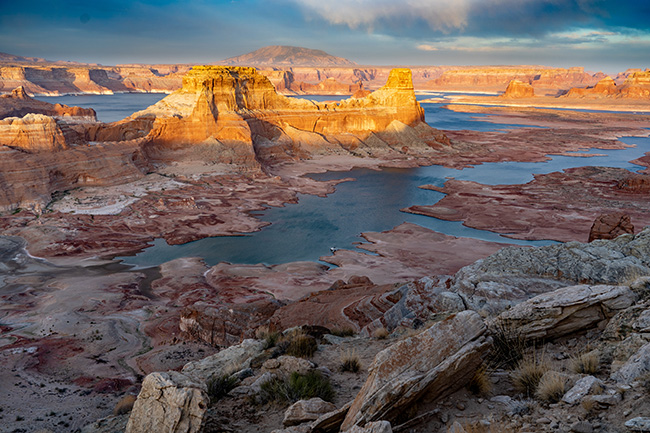
As the animations below dramatically illustrate, this was indeed a boom year for snow in the western United States. This is especially true for water-depleted California, as well as the mega-drought-stricken Colorado River Basin, whose dwindling waters support a $1.4 trillion economy.
Before and after satellite images, one taken on April 8, 2022 by the NOAA-20 satellite and the other on April 10, 2023 by the Suomi-NPP spacecraft, show a dramatic difference in snowpack in the mountains of the American West. Currently, snowpack is well above average almost everywhere. (Credit: Images from NASA Worldview, animation by Tom Yulsman)
The incredible snowpack in California’s Sierra Nevada mountain range continues to make headlines — especially as a growing heat wave threatens to cause a dramatic meltdown, which increases the already high flood risks. As of April 26, snowpack levels in the Sierra Nevada were more than 200 percent of average for the date. In the southern Sierra, the score was over 300 percent of the average.
Such numbers are not unusual exactly now throughout the western US, as this map shows:
Credit: USDA/NRCS National Center for Water and Climate
All those blues and greens show where the snowpack is above average.
The abundance of snow in the mountains of the Colorado River Basin is a relief to the 40 million people in seven states, Mexico and numerous Indian tribes who depend on its waters. The two major reservoirs, Lake Powell and Lake Mead, that have been essential to meeting their water needs have dropped to record low levels. And water levels in other reservoirs in the basin have dropped dramatically.
Postponement
But now the snowpack gives hope that further declines can be avoided – at least in the upcoming warm season. Based on current forecaststhe storage tank for the basin as a whole will be at about 44 percent of capacity on September 30, the end of water year 2023. That’s a 33 percent increase at the start of the water year on October 1, 2022. A bit of good news for a change—but almost certainly not for the long term.
Before and after satellite views of the Colorado Rockies, the first captured on April 4, 2022, and the second on April 16 of this year. (Credit: Images from NASA Worldview, animation by Tom Yulsman)
“This winter’s snowpack is promising and gives us an opportunity to help restore Lakes Mead and Lake Powell in the short term, but the reality is that drought conditions in the Colorado River Basin have been more than two decades in the making,” the U.S. Bureau said of Reclamation Commissioner Camille Calimlim Towton, in a statement.
Recent studies shows that the region is in the grip of the region’s worst such drought in at least 1,200 years. Just over 40 percent of its weight is attributed in the study to human-caused climate change, largely from warming temperatures that have caused increasing dryness.
As Touton notes, “Despite this year’s nice snow, the Colorado River system remains at risk from the continued impacts of the climate crisis.”
Landsat-8 views of the headwaters of the Colorado River show a dramatic difference in snowpack between April 2022 and 2023. In both images, bodies of water have been artificially rendered blue to make them stand out. (Credit: Images via Sentinel Hub, animation by Tom Yulsman)
Assuming this year’s abundance of snow produces the expected runoff into streams and rivers—which isn’t really a given—that will buy policymakers a little more time to make some very difficult decisions about how to deal with an inescapable fact: Many more water is released for agricultural, industrial, and municipal uses combined than flows into the Colorado River. That, of course, is why Lakes Mead and Powell have declined to record low levels. And thanks to the climate crisis, in the long term, the deficit in flows is unlikely to be reversed.
This long-term outlook is due to warming temperatures from rising concentrations of carbon dioxide and other greenhouse gases in the atmosphere – which continues their historically high growth rates in 2022, according to NOAA scientists.
“The bottom line is that in order to see any kind of reduction in the rate of CO2 growth, emissions reductions have to be sustained and significant,” says Arlene Andrews, head of NOAA’s Carbon Cycle Greenhouse Gas Group.
We are nowhere close to cutting emissions right now. Exactly the opposite. In 2022, global energy-related CO2 emissions rose by 0.9 percent, according to the International Energy Agencyreaching a record high of nearly 37 billion tons.

